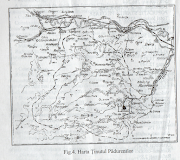“You have to constantly try to climb very high, if you want to be able to see far-away
Arriving at the gates of Heaven, on the Hunedoara-Teliuc-Ghelari road, you have to go under the clock arch that adorns the big gate. Also at the entrance you will notice two saints in folk costumes from the area. The dimensions of the cathedral are remarkable: 47 m high, 21 m wide and 47 m long, to which are added the symbolism of the 7 towers, 7 years the duration of the interior painting by the painter Constantin Nițulescu.
He found a lot of support in the people of Ghelari, peasants hardened by the harshness of the place but with pure soul. Out of need of money, a mixed choir was organized in the village, which together with the Ghelari fanfare (founded at the end of the 19th century) toured the country. If you remember dear readers, we talked about this choir some time ago. The "Work and Light" choir, which this year celebrated its 80th anniversary. These people with a big heart and eager to build together with their priest the great cathedral travelled all over the country, to large enterprises in all cities of the country to raise funds for the monumental construction.
During 1945-1955 the works at the church stopped due to the communist persecution to which the priest Nerva also fell prey. He was arrested and the authorities were unable to handcuff him. They just didn't close. Was it a miracle from God for the priest's toil and the fulfillment of the commandment? Many agree with this approach to the subject. After no charges were found, Priest Nerva was released from prison. The works were resumed in 1955, the church being completed in 1973 when, on November 3, it was sanctified.
The construction is made of brick with walls over 1 m thick, the construction style being that of "heavenly cross". The architecture combines several styles, the specialists not being able to pronounce. It has its own style. The church has seven towers, two in front with a height of 47 m, the most imposing being the one in the middle of the church-dome. The sacrifices of the locals for the construction of the church were many. The materials were brought by train to the base of the hill on which Ghelar is located, and from there by ox cart. Sometimes they were drawn with an inclined plan, they were transported again by train through the mine galleries, then by a funicular (specially built) near the church, then by cart to the construction site, because the only way to communicate with the city of Hunedoara (located 18 km) was the one mentioned. Later, a road was built connecting Ghelar to Hunedoara (1958).
Earlier we talked about the painting made in this church. The painting in the "buon fresco" style was made on about 4000 square meters. Each painted saint 'orients himself' according to the person looking at him. The iconostasis is polished in gold, as are the icons. The main painter of the church was Constantin Nițulescu. The painting of the church lasted seven years (1960-1967), despite the fact that five painters worked on it. The sculpture is made of solid oak, being made entirely by the artist Ioan Cristea.
Starting with 1980, the church began to feel the movements of the field. Long cracks appeared on the walls of the church. The only solution to stop the effects of the movements was consolidation, a project that was started immediately. With the death of the priest Florea, many of the plans for the arrangement of the church were extinguished. His vision was to clothe the church in mosaic painting, to be surrounded by seven artesian wells, and to be sumptuously paved with white marble.
In 2004, following the steps taken by the parish priest Vlad Vasile and other officials, the church entered the governmental restoration program and over 20 billion old lei were invested. The restoration causes the entire resistance structure to be strengthened, with deep concrete injections being made throughout the hill on which the church is built. After the restoration, the church is painted on the outside and cherubs are painted on the walls of the towers. Thus, the church looks the same as in Father Florea's dreams. The stairs at the entrance to the church and the entire church, at the base, are paved with marble, and the icon on the dome at the entrance to the church is made of mosaic.
On July 4, 2010, the Pădurenilor Cathedral was reconsecrated, where several dozen priests and sons of the village took part, headed by the Most Holy Bishop of the Diocese of Deva and Hunedoara, Bishop Gurie. At the same time, in the perimeter of the church there is a museum with the wonders of the place: traditional costumes, old books, objects from the foresters' garden and objects of church worship.
Until the 90's, old women wore the traditional foresters costume, a model of high national consciousness, the ancestral dowry bearers, who ennobled the services by presence, came to the church . The value of the place and its significance can also be described due to the large number of sons of the village / church. They later became theologians and good people, fearing God, being spread through various parishes throughout the county, and beyond.
The sunsets, during the summer nights, are spectacular, trying to caress, protective, the cathedral. The interior is immersed in a warm, unreal light. It is good to know about the existence of such a place, only 28 km from the Prislop Monastery, which you must discover in your travels to places that carry this level of spirituality. The feelings you can have there and the peace with which the soul is charged, are indescribable. The Cathedral of the Foresters is waiting for you all to step on its doorstep! God help us!



























0 Comments